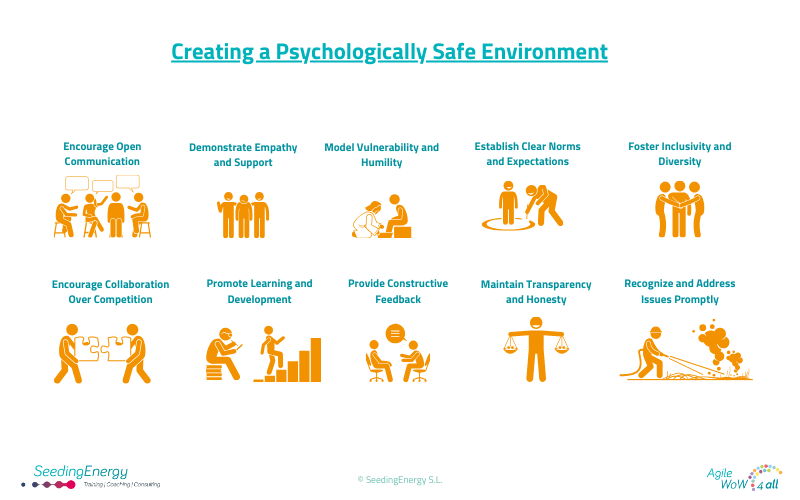

22/05/2024
Psychological Safety: A Guide for Team Leaders
In today’s dynamic work environment, fostering psychological safety is paramount for team success. Psychological safety, defined as a shared belief that the team is safe for interpersonal risk-taking, is crucial for innovation, collaboration, and overall team well-being. Here’s how team leaders can create and maintain a psychologically safe environment.
1. Encourage Open Communication
Encourage team members to speak up without fear of retribution. Create an environment where questions, concerns, and ideas are welcomed and valued. Implement regular check-ins and open forums where team members can voice their thoughts.
Action Steps:
- Hold regular, inclusive meetings where everyone has a chance to speak.
- Use anonymous surveys to gather honest feedback.
- Practice active listening, showing genuine interest in team members’ input.
2. Demonstrate Empathy and Support
Show empathy towards team members’ concerns and challenges. Acknowledge their feelings and provide support when needed. This helps in building trust and a sense of security.
Action Steps:
- Be approachable and available for one-on-one conversations.
- Show understanding and compassion in response to mistakes or failures.
- Provide resources for mental health and stress management.
3. Model Vulnerability and Humility
Leaders should model the behavior they wish to see in their teams. By being open about your own mistakes and uncertainties, you can set a precedent that it’s okay to be imperfect.
Action Steps:
- Share your own challenges and learning experiences with the team.
- Admit when you don’t know something and seek input from the team.
- Celebrate failures as learning opportunities.
4. Establish Clear Norms and Expectations
Set clear expectations about team interactions and behavior. Establishing norms around respect, inclusivity, and constructive feedback helps in creating a predictable and safe environment.
Action Steps:
- Develop and communicate a team charter outlining behavioral expectations.
- Reinforce norms through consistent actions and policies.
- Address any behavior that violates team norms promptly and fairly.
5. Foster Inclusivity and Diversity
Embrace and celebrate the diverse backgrounds and perspectives of your team members. An inclusive environment where everyone feels valued and respected enhances psychological safety.
Action Steps:
- Ensure all team members have equal opportunities to contribute.
- Recognize and celebrate different cultural and personal backgrounds.
- Provide diversity and inclusion training to the team.
6. Encourage Collaboration Over Competition
Promote a culture of collaboration rather than competition. Encourage teamwork and collective problem-solving, where everyone’s input is valued and utilized.
Action Steps:
- Implement team-based goals and rewards.
- Facilitate team-building activities that emphasize collaboration.
- Recognize and reward collaborative efforts and successes.
7. Provide Constructive Feedback
Offer feedback in a way that is constructive and supportive. Focus on the behavior or outcome, not the individual. Ensure feedback is a two-way process, where team members feel comfortable providing feedback to you as well.
Action Steps:
- Use the “situation-behavior-impact” (SBI) model for giving feedback.
- Encourage a feedback culture where regular, informal feedback is the norm.
- Provide training on how to give and receive feedback constructively.
8. Promote Learning and Development
Encourage continuous learning and development. When team members feel that their growth is supported, they are more likely to take risks and engage more fully with their work.
Action Steps:
- Offer professional development opportunities and resources.
- Encourage experimentation and innovation.
- Celebrate learning milestones and achievements.
9. Maintain Transparency and Honesty
Be transparent about decisions, changes, and challenges. Honest communication fosters trust and reduces uncertainty, making team members feel safer.
Action Steps:
- Share relevant information openly and promptly.
- Explain the rationale behind decisions and changes.
- Be honest about challenges and involve the team in finding solutions.
10. Recognize and Address Issues Promptly
When issues arise, address them quickly and effectively. Ignoring problems can erode psychological safety, while timely interventions can reinforce it.
Action Steps:
- Monitor team dynamics and be alert to signs of distress or conflict.
- Address conflicts and issues promptly and constructively.
- Seek input from the team on how to resolve issues and improve the environment.

Creating a psychologically safe environment is an ongoing process that requires commitment, empathy, and proactive leadership. Team leaders can create a workplace where everyone feels safe to express themselves and contribute their best work by fostering open communication, demonstrating support, modeling vulnerability, and promoting inclusivity. This, in turn, leads to higher engagement, innovation, and overall team success.
We can help accompany you and your team leaders to create a psychologically safe environment. If you want to learn more, please do not hesitate to contact us!
